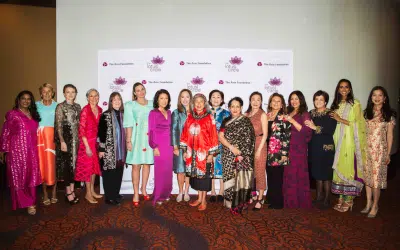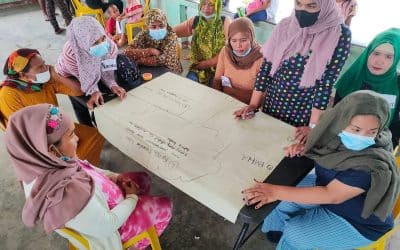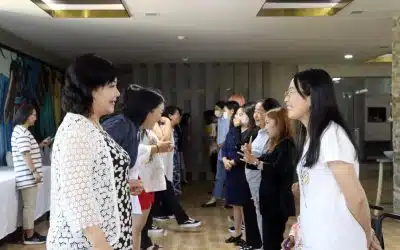InAsia
Insights and Analysis
Community Mediation in Nepal: “A Hospital That Stitches Broken Hearts”
February 13, 2019
Much of Nepal is mountainous and remote, connected by unimproved roads and paths and far from the services and amenities of the city. Among those services is the formal justice system, a central function of the state that has long been out of reach for poor and rural Nepalis. It takes considerable time and money to travel to a district court and file a complaint. Illiteracy is widespread in rural Nepal, and many are unfamiliar with the legal system or their own rights. As a result, Nepalis have long relied on traditional mechanisms to resolve local disputes.
But indigenous customs and dispute-resolution mechanisms often imposed their own injustices. In Nepal’s patriarchal, class- and caste-dominated society, traditional dispute resolution often revolved around powerful members of the community, to the disadvantage of the powerless. Men, the wealthy, the educated, and the politically influential were well-served by the traditional system, while women, the elderly, Dalits, and other vulnerable and marginalized groups at the bottom of the social power structure had no voice. Decisions were often handed down based on power relations, having little to do with the facts of the case. Weaker parties often shied away from asserting their claims.

Ongoing mediation process
As Nepali society became more heterogeneous—due to massive population shifts during the 10-year civil war, migration for work and education, and rapid urbanization—village traditions found themselves at odds with the shifting sociocultural landscape. The old ways of resolving conflicts were seen as reasserting prejudice, reinforcing old power relations, and perpetuating the culture of patriarchy and social exclusion. Moreover, the old ways paid little attention to mending broken relationships. With the uncertainties of Nepal’s political transition, the lingering trauma of civil war, and the weakness of the state, particularly in rural areas, a new approach to dispute resolution was needed.
Since 2001, The Asia Foundation’s community-mediation program has offered an alternative way for communities to de-escalate conflicts related to land, property, business transactions, family quarrels, defamation, and domestic violence. Departing from the traditional hierarchical paradigm, community mediation uses an “interest-based” approach that emphasizes inquiry, understanding, respect for disputing parties’ needs, and recognition of their legitimate interests.
A key element is the selection of local mediators who mirror the gender, ethnic, class, and religious diversity of the community. The mediator-selection process involves both the community and local government, strengthening state-society relations. With training, these local mediators learn to recognize and resist the pull of partiality towards the disputants and uphold nonnegotiable values such as freedom, justice, dignity, respect, and fundamental human rights.
Community mediation empowers weaker parties by respecting their interests. Justice seekers, especially women and marginalized groups, no longer feel isolated or helpless to deal with conflicts. In cases where the less powerful may feel pressure to accept a hasty settlement because they don’t know their rights or the law, trained mediators may refer them to a legal-aid program. If mediators believe that a disputant needs emotional help, they refer them to a psychosocial counselor. In cases where mediators feel that a disputant needs protection, they are referred to the police or other social-service providers.

Training of mediators
In addition to resolving conflict, community mediation rebuilds relationships in the community—between different ethnic groups, the rich and the poor, high castes and “untouchables,” women and men—by encouraging parties to understand one another’s point of view and promoting empathy and compassion. Nepal’s community mediators often call it “a hospital that stitches broken hearts.” A key to that has been learning to use an appropriate vocabulary, in local languages, based on concepts such as justice, harmony, conflict, and neutrality. This adaptation has helped develop new training approaches tailored to the needs of local populations and provoked careful reflection on how mediation is understood and promoted in Nepali communities.
One interesting result is that mediators consistently report personal changes including a significant increase in their own self-esteem, in their capacity to participate in community processes and decision-making, and in their confidence and leadership in local conflicts. Women and mediators from marginalized communities in particular have reported these changes, and the presence of female mediators has gradually reduced men’s prejudices against women and changed their perceptions of women’s social roles.
The impact of community mediation has reached far beyond the many successful settlements, beyond access to justice, to deeper changes in social norms. Community mediation has strengthened communication and mutual respect across caste, class, gender, and economic lines and increased public participation by members of historically less privileged groups.

Community mediators in front of mediation center in far western Nepal
Despite early resistance from traditional elites, this interest-based approach has gradually won acceptance, as settlements based on the parties’ mutual interests have proven to be effective and durable. Today community mediation is firmly established, subject to formal legal standards and recognized in the Constitution of Nepal.
And it has stood the test of time. Even at the height of the armed insurgency, community mediation was a powerful tool to address local grievances. As the practice has flourished, it has evolved in sophistication to handle not just interpersonal conflicts but a variety of complex, multi-stakeholder disputes involving ethnic or religious identity, public policy, natural resources, and development. The Foundation is now leading an initiative to incorporate restorative justice to address historical, social, or structural inequities and to heal, reconcile, and transform conflict.
Community mediation works because it appeals to the best of the Nepali conscience to promote empathy, compassion, and humility and to rehumanize and heal people so that they have the strength, together, to build a fair, just, and peaceful society. Traumatized by civil war, Nepal needed a comprehensive peacebuilding approach at the local level to consolidate peace at the national level. Two decades later, community mediation has become that “hospital stitching broken hearts.”
The Asia Foundation’s community mediation program is supported by Australia’s Department of Foreign Affairs and Trade (DFAT). Preeti Thapa is a program director and Namit Wagley is a program officer for The Asia Foundation in Nepal. They can be reached at [email protected] and [email protected], respectively. The views and opinions expressed here are those of the authors, not those of The Asia Foundation.
1 Comment
About our blog, InAsia
InAsia is posted and distributed every other Wednesday evening, Pacific Time. If you have any questions, please send an email to [email protected].
Contact
For questions about InAsia, or for our cross-post and re-use policy, please send an email to [email protected].The Asia Foundation
465 California St., 9th Floor
San Francisco, CA 94104
The Latest Across Asia
News
April 25, 2024
Program Snapshot
April 18, 2024
News
April 17, 2024

2024 Lotus Leadership Awards
The Lotus Leadership Awards recognize contributions towards gender equality in Asia and the Pacific







Thanks for Preeti Thapa & Namit ji. It is a great information great work in nepali context for social justice and up grading social harmony in our society.